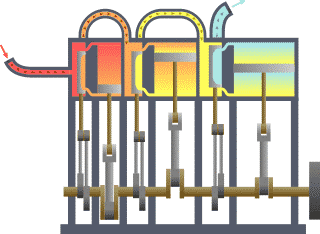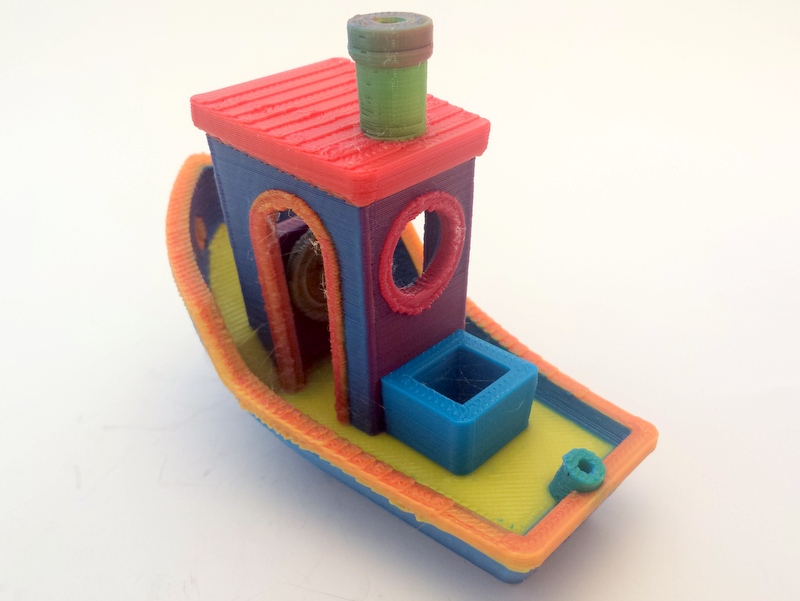|
Herringbone Gear
A herringbone gear, a specific type of double helical gear, is a side-to-side, rather than face-to-face, combination of two helical gears of opposite hands. From the top, each helical groove of this gear looks like the letter V, and many together form a herringbone pattern (resembling the bones of a fish such as a herring). Unlike helical gears, herringbone gears do not produce an additional axial load. Like helical gears, they have the advantage of transferring power smoothly, because more than two teeth will be enmeshed at any moment in time. Their advantage over the helical gears is that the side-thrust of one half is balanced by that of the other half. This means that herringbone gears can be used in torque gearboxes without requiring a substantial thrust bearing. Because of this, herringbone gears were an important step in the introduction of the steam turbine to marine propulsion. Manufacture Precision herringbone gears are more difficult to manufacture than equivalent ... [...More Info...] [...Related Items...] OR: [Wikipedia] [Google] [Baidu] |
Gear Shaper
A gear shaper is a machine tool for cutting the teeth of internal or external gears, it is a specialised application of the more general shaper machine. The name shaper relates to the fact that the cutter engages the part on the forward stroke and pulls away from the part on the return stroke, just like the clapper box on a planer shaper.Woodbury, Robert S. ''Studies in the history of machine'' ''tools''. Cambridge, Mass. :M.I.T. Press, 1972 The cutting tool is also gear shaped having the same pitch as the gear to be cut. However number of cutting teeth must be less than that of the gear to be cut for internal gears. For external gears the number of teeth on the cutter is limited only by the size of the shaping machine. The principal motions involved in rotary gear shaper cutting are of the following : # ''Cutting Stroke'': The downward linear motion of the cutter spindle together with the cutter . # ''Return Stroke'': The upward linear travel of the spindle and cutter to withdra ... [...More Info...] [...Related Items...] OR: [Wikipedia] [Google] [Baidu] |
Powertrain
In a motor vehicle, the powertrain comprises the main components that generate engine power, power and deliver that power to the road surface, water, or air. This includes the internal combustion engine, engine, transmission (mechanics), transmission, drive shafts, differential (mechanics), differentials, and the final drive (drive wheels, continuous track as in military tanks or caterpillar tractors, propeller, etc.). Hybrid powertrains also include one or more electric traction motors that operate to drive the vehicle wheels. All-electric vehicles ("electric cars") eliminate the engine altogether, relying solely on electric motors for propulsion. Occasionally the term powerplant is casually used to refer to the engine or, less often, the entire powertrain. A motor vehicle's driveline or drivetrain consists of the parts of the powertrain excluding the engine. It is the portion of a vehicle, after the prime mover (locomotive), prime mover, that changes depending on whether a v ... [...More Info...] [...Related Items...] OR: [Wikipedia] [Google] [Baidu] |
Mors (automobile)
The Mors automobile factory was an early French car manufacturer. It was one of the first to take part in automobile racing, beginning in 1897, due to the belief of the company founder, Émile Mors, in racing's technical and promotional benefits. By the turn of the century, automobile racing had become largely a contest between Mors and Panhard et Levassor. Technical achievements Mors was one of the first automobiles to use the V engine configuration. The Mors 60 horsepower Grand Prix car was powered by a 9.2-litre V4 side valve engine, with magneto ignition and dry sump lubrication, which could reach 950 rpm. The car had a steel chassis and a four-speed transmission that drove the rear wheels via chain drive, and rear-wheel brakes. In 1902, Mors added pneumatic shock absorbers to their cars, which represented a great leap forward given the quality of the roads and racetracks at the time. With this car, Henri Fournier was able to win the highly significant Paris ... [...More Info...] [...Related Items...] OR: [Wikipedia] [Google] [Baidu] |
André Citroën
André-Gustave Citroën (; 5 February 1878 – 3 July 1935) was a French industrialist and the founder of French automaker Citroën. He is also remembered for his application of double helical gears. Life and career Born in Paris in 1878, André-Gustave Citroen was the fifth and last child of Jewish parents, diamond merchant Levie Citroen and Masza Amelia Kleinman. He was a cousin of the British philosopher Sir A. J. Ayer (the only son of his aunt Reine). The Citroen family descended from a grandfather in the Netherlands who had been a greengrocer and seller of tropical fruit, and had taken the surname of , Dutch for "lime man"; his son however changed it to (), which in Dutch means "lemon". In 1873 the family moved to Paris; upon arrival, the French was added to the surname (reputedly by one of André's teachers), changing to . His father died by suicide when André was six years old (presumably after failure in a business venture in a diamond mine in South Africa). It ... [...More Info...] [...Related Items...] OR: [Wikipedia] [Google] [Baidu] |
Citroën
Citroën ()The double-dot diacritic over the 'e' is a diaeresis () indicating the two vowels are sounded separately, and not as a diphthong. is a French automobile brand. The "Automobiles Citroën" manufacturing company was founded on 4 June 1919 by André Citroën. Citroën has been owned by Stellantis since 2021 and previously was part of the PSA Group after Peugeot acquired 89.95% share in 1976. Citroën's head office is located in the Stellantis Poissy Plant in Saint-Ouen-sur-Seine since 2021 (previously in Rueil-Malmaison) and its offices studies and research in Vélizy-Villacoublay, Poissy (CEMR), Carrières-sous-Poissy and Sochaux-Montbéliard. In 1934, the firm established its reputation for innovative technology with the Citroën Traction Avant, Traction Avant. This was the world's first car to be mass-produced with front-wheel drive and four-wheel independent suspension, as well as unibody construction, omitting a separate chassis, and instead using the body of the car ... [...More Info...] [...Related Items...] OR: [Wikipedia] [Google] [Baidu] |
Herringbone Double-helical Bevel Gears, Citroens Patent (Autocar Handbook, Ninth Edition)
Herringbone may refer to: *Herring-Bone (card game), a game of patience *Herringbone (cloth), a woven pattern of tweed or twill cloth *Herringbone (formation), a type of military formation * Herringbone (horse) (1940–1961), a Thoroughbred racehorse *Herringbone cross-stratification, a sedimentary structure in geology that is formed from back-and-forth tidal water flow *Herringbone gear, a type of gear *Herringbone pattern, a pattern of floor tiling or paving *Herringbone seating, a pattern of airliner seating *A bonding pattern of brickwork, also known as opus spicatum * Herringbone stitch *A type of braided hairstyle, which is also known as a fishtail braid *A distortion pattern from deinterlacing video called mouse teeth *A method of counting used with the unary numeral system *A technique of moving one's skis while cross-country skiing * Herringbone milking shed *Herringbone, another name for the medical condition scintillating scotoma *"Herringbone", a song by Department of ... [...More Info...] [...Related Items...] OR: [Wikipedia] [Google] [Baidu] |
Destroyer Escort
Destroyer escort (DE) was the United States Navy mid-20th-century classification for a warship designed with the endurance necessary to escort mid-ocean convoys of merchant marine ships. Development of the destroyer escort was promoted by the British need in World War II for anti-submarine ships that could operate in open oceans at speeds of up to 20 knots. These "British Destroyer Escort"s were designed by the US for mass-production under Lend Lease as a less expensive alternative to fleet destroyers. The Royal Navy and Commonwealth forces identified such warships as frigates, and that classification was widely accepted when the United States redesignated destroyer escorts as frigates (FF) in 1975. From circa 1954 until 1975 new-build US Navy ships designated as destroyer escorts (DE) were called ocean escorts. Similar types of warships in other navies of the time included the 46 diesel powered '' Kaibōkan'' of the Imperial Japanese Navy, 10 ''Kriegsmarine'' F-class escor ... [...More Info...] [...Related Items...] OR: [Wikipedia] [Google] [Baidu] |
Triple-expansion Steam Engine
A compound steam engine unit is a type of steam engine where steam is expanded in two or more stages. A typical arrangement for a compound engine is that the steam is first expanded in a high-pressure (HP) Cylinder (engine), cylinder, then having given up heat and losing pressure, it exhausts directly into one or more larger-volume low-pressure (LP) cylinders. Multiple-expansion engines employ additional cylinders, of progressively lower pressure, to extract further energy from the steam. Invented in 1781, this technique was first employed on a Cornish beam engine in 1804. Around 1850, compound engines were first introduced into Lancashire textile mills. Compound systems There are many compound systems and configurations, but there are two basic types, according to how HP and LP piston strokes are phased and hence whether the HP exhaust is able to pass directly from HP to LP (Arthur Woolf, Woolf compounds) or whether pressure fluctuation necessitates an intermediate "buffer" ... [...More Info...] [...Related Items...] OR: [Wikipedia] [Google] [Baidu] |
Production Bottleneck
In production and project management, a bottleneck is a process in a chain of processes, such that its limited capacity reduces the capacity of the whole chain. The result of having a bottleneck are stalls in production, supply overstock, pressure from customers, and low employee morale. There are both short and long-term bottlenecks. Short-term bottlenecks are temporary and are not normally a significant problem. An example of a short-term bottleneck would be a skilled employee taking a few days off. Long-term bottlenecks occur all the time and can cumulatively significantly slow down production. An example of a long-term bottleneck is when a machine is not efficient enough and as a result has a long queue. An example is the lack of smelter and refinery supply which cause bottlenecks upstream. Another example is in a surface-mount technology board assembly line with several pieces of equipment aligned. Usually the common sense strategy is to set up and shift the bottleneck elem ... [...More Info...] [...Related Items...] OR: [Wikipedia] [Google] [Baidu] |
3D Printing
3D printing, or additive manufacturing, is the construction of a three-dimensional object from a CAD model or a digital 3D model. It can be done in a variety of processes in which material is deposited, joined or solidified under computer control, with the material being added together (such as plastics, liquids or powder grains being fused), typically layer by layer. In the 1980s, 3D printing techniques were considered suitable only for the production of functional or aesthetic prototypes, and a more appropriate term for it at the time was rapid prototyping. , the precision, repeatability, and material range of 3D printing have increased to the point that some 3D printing processes are considered viable as an industrial-production technology; in this context, the term ''additive manufacturing'' can be used synonymously with ''3D printing''. One of the key advantages of 3D printing is the ability to produce very complex shapes or geometries that would be otherwise infeasi ... [...More Info...] [...Related Items...] OR: [Wikipedia] [Google] [Baidu] |






